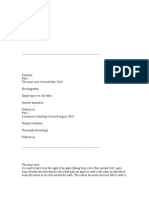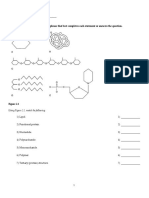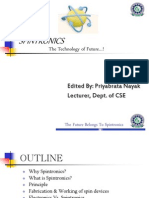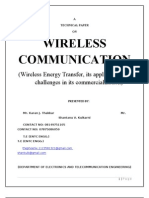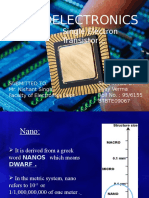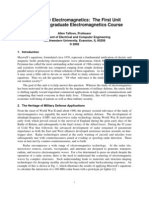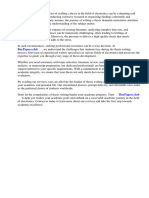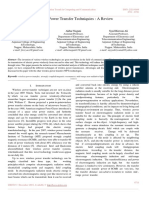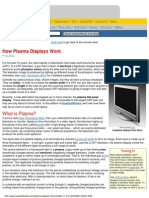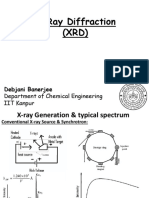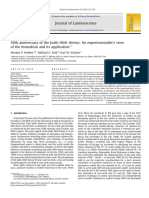0 ratings0% found this document useful (0 votes)
34 views226 Libre
226 Libre
Uploaded by
PriyaSinghspintronics
Copyright:
© All Rights Reserved
Available Formats
Download as PDF, TXT or read online from Scribd
226 Libre
226 Libre
Uploaded by
PriyaSingh0 ratings0% found this document useful (0 votes)
34 views9 pagesspintronics
Original Title
226-libre
Copyright
© © All Rights Reserved
Available Formats
PDF, TXT or read online from Scribd
Share this document
Did you find this document useful?
Is this content inappropriate?
spintronics
Copyright:
© All Rights Reserved
Available Formats
Download as PDF, TXT or read online from Scribd
Download as pdf or txt
0 ratings0% found this document useful (0 votes)
34 views9 pages226 Libre
226 Libre
Uploaded by
PriyaSinghspintronics
Copyright:
© All Rights Reserved
Available Formats
Download as PDF, TXT or read online from Scribd
Download as pdf or txt
You are on page 1of 9
Proceedings of the 5th National Conference; INDIACom-2011
Computing For Nation Development, March 10 11, 2011
Bharati Vidyapeeths Institute of Computer Applications and Management, New Delhi
Spintronics-A New Light in Nanoscale Devices
Namit Gupta1, Kamal Chaudhary2 and Sumant Katiyal3
1
namitg@hotmail.com, 2kkchoudhary1@yahoo.com and 3sumant578@yahoo.com
ABSTRACT
Spintronics is the field in which the spin degree of freedom of
the electron plays an important role in addition to or in place
of the charge degree of freedom in mainstream electronics.
Spin of an electron, although not given sincere wattage till now
can play a very vital role in understanding the transport
phenomenon of charge in nano scale devices. Adding spin
degree of freedom to electrons will provide significantly more
capability and performance to the nano scale electronic
devices [1]. Spin transport effects and spin polarization have
been very well defined using ferromagnetic materials. The
electrons at or very near to the Fermi surface, in the
ferromagnetic materials are partially spin polarized. The
larger the degree of spin polarization of these electrons, the
bigger the spin transport effects. Spin based devices such as
Spin-FETs , Spin-LEDs , Spin- resonant tunneling devices ,spin
coherent devices and spin quantization devices are now real
and at the verge of implementation. Our Tutorial paper tries to
exaplore the various possibilities of research in the field of
Nano structured devices, using Spintronics as the basis of nano
devices.
KEYWORDS
Spintronics, Spin degree of freedom, GMR, MTJ, Spin
Polarization and QCA
1. INTRODUCTION
Spin is a purely quantum phenomenon roughly akin to the
spinning of a childs top or the directional behavior of the
compass needle. The top could spin in the clockwise or
counterclockwise directions, electronics have spin of a sort in
which their compass needle can point either up or down in
relation to a magnetic field. Thus a new kind of binary logic of
ones and zeros can be led by spin of an electron. [2] Spin can
be easily manipulated by an externally applied magnetic field.
Another property which is shown by the spin of an electron is
its long coherence or relaxation time. Once spin is created it
tends to stay that way for a long time. This enables the electron
charge to be transported for a longer duration of time, unlike
the conventional charge states, which are easily destroyed by
scattering or collision with defects or impurities or other
changes. These characteristics open the possibility of
developing devices that could be much smaller, consume less
electricity and be more powerful for certain types of
computations than is possible with electron charge based
systems.
An important challenge for the nanotechnologists in the
molecular computing community is to develop a design
methodology and an associated two-terminal device which
isolates its inputs from its outputs without requiring a clock [3].
Additionally, whatever strategy is employed should not require
global analysis in order to understand the behavior of a local
structure.
All spin-transport devices are based on the effect that the
magnetic spin of electrons can be manipulated in optoelectronic devices by magnetic fields or applied voltage. The
domain of spin-transport devices is commonly referred to as
magneto electronics or Spintronics. The spin transport effects
are most widely used today in magnetic metallic devices such
as read heads for Hard Disk Drives and in Magnetic Random
Access Memories (MRAM). These device structures comprise
magnetic thin films, the magnetic orientation of which can be
changed with applied magnetic fields. In case of non-volatile
MRAM the orientation will be preserved until the bit is
switched again. Hence, a locally generated field performs the
writing of a magnetic bit, by currents in the vicinity of the
magnetic structure. The reading principle of magnetic bits is
based on the discrimination between two distinct magnetic
states in the device by measuring the (tunnel) resistance in the
device. In future generations semiconductor-based spininjection components are expected to play a significant role.
Spin valve devices, Tunnel junction devices and spin injection
devices are few major initiatives in this field.
2. CHALLENGES AND ISSUES
The main difficulties related to spin devices are summarized as
follows:
Tunnel Junction Devices: In order to have optimum
resistances (of about 50 Ohm) future high density tunnel
junction MRAM will require thin tunnel junctions of the order
of a nanometer. The spread of the junctions must be at
Angstrom-level for achieving the uniformity needed for high
density. This requires a high precision in manufacturing.
Tunnel Junction Devices: The current bottleneck for reducing
the MRAM cell size is limited by the semiconducting diode /
transistor that avoid the shortcuts in the array (blocking diode).
For large-scale integration, either the size of the blocking diode
must be reduced or alternatively the spin device itself must
perform the blocking function.
Spin injection devices: Although spin injection into a
semiconductor has been demonstrated, it is still to be proven
that the materials and the concept are suitable for room
temperature operation and large scale
Copy Right INDIACom-2011 ISSN 0973-7529 ISBN 978-93-80544-00-7
Proceedings of the 5th National Conference; INDIACom-2011
There is a strong possibility of developing new architectures
for the nanoscale devices, as the existing architectural models
are all time tested for the CMOS circuits [2]. These new
architectures will definitely be helpful for the devices to
succeed in nanoscale. Quantum computing is one such
architecture, which is useful for the few of the nanoelectronics
applications [4]. In this proposed work it is planned to develop
the theoretical models to deal with the spin property of
electrons and the effect of spin polarization and spin fluctuation
on the electronics properties used in the nano electronics. In
proposed model the spin properties such as the spin precession,
spin diffusion, spin drift, and spin relaxation will be modeled to
explain the electronic properties viz. current, resistance,
relaxation time of electron and magnetic properties those have
significant impact on the applications of nano structures in the
electronic technology.
Spin relaxation (how spins are created and disappears) and spin
transport (how spin moves in metals and semiconductors) [5]
are fundamentally important not only as basic physics value but
also because of their demonstration value as phenomena in
electronics technology. For E.g. GMR (Giant magneto
resistive) Short term studies of spin transport properties of
semiconductor, have made us understood that the spin
properties of an electron can be very useful for the application
of electron and nuclear spin to quantum computing and
quantum information processing. Quantum algorithm given by
Peter Shor of Bell laboratories, would factor large numbers into
primes, which is very typical task in conventional computers,
proves an immense possibility for spin devices well suited for
quantum computing/ quantum information processing.
Datta Das were [6, 7, 8] the first to give a scheme for the
Spintronics device based on MOS technology. In their scheme
they proposed that in FET like structures made of InAlAs and
InGaAs, the gate electrode produces a field that forces the
electron spin for precess. And the electron current is modulated
by the degree of precession in electron spin introduced by the
gate field. Mark Johnson at Naval research laboratory, in his all
metal spin transistor model, inspired by the GMR (a tri layer
structure), tried to control the current by an applied magnetic
field. Thus device can act as Switch or Spin Valve. Due to its
all metallic structure its miniaturization was very much
possible at nanoscale level, but a disadvantage of not acting as
amplifier is also associated with it. Thus it is very obvious that
the Daas-Datta model is still suitable for nanoscale devices. But
the major drawback comes that what about the spin transport at
interfaces, particularly at ferromagnet/semiconductor interface.
I will be trying to explore this part of the device characteristics.
Recently, a nano FET design given by Igor Zutic proposes the
use of magnetic field instead of electric field, producing same
physical effect and also resulting in spin polarized current due
to spin up and spin down effect. In all the above mentioned
considerations , the study regarding the spin up and spin down
of an electron on application of a magnetic field has been
observed, but most of the authors have suggested mainly two
states, i.e. spin up and spin down states only. The basic
equation for the electron spin based on the characteristic
parameters of an electron such as electron mass, charge, drift
velocity, Fermi velocity, electron relaxation time is presented
by Gengyun Li
The above discussion indicates that future electronic devices to
be used in communication systems, computing systems,
Instrumentation systems etc will inevitably be built using
nanoelectronics, i.e., from devices and wires with feature sizes
below twenty to thirty nanometers. The SIA roadmap [10]
predicts that traditional silicon-based systems will have feature
sizes of below 20 nm within the decade. There are also
advances being made in building computing systems using new
technologies, such as molecular electronics [11]. Successfully
harnessing nanoelectronics requires a rethinking of the
abstractions and models that are the basis of designing all such
systems. While each technology has its own unique
requirements, we show that new abstractions are necessary
strictly because the feature sizes are nanoscale. The transistor
has proven an extremely useful building block for digital logic.
In addition to its switching properties, it can be used to
construct logical gates which isolate their inputs from their
outputs (I/O isolation) and it has gain which promotes noise
immunity [12]. Some nanoelectronics technologies have no
equivalent device. In addition, as dimensions scale down, the
wires used to connect the devices become the dominant source
of signal delay and power consumption [10].
3. LITERATURE REVIEW
Spintronics (sometimes also referred to as magnetoelectronics although we prefer the spintronics terminology
because a magnetic field or the presence of a magnetic material
is not necessarily essential for manipulating spins) is the
emerging field [l3,14] of active control of carrier spin dynamics
and transport in electronic materials (particularly, but not
necessarily limited to, semiconductors). In some sense, existing
technologies such as GMR-based memory devices and spin
valves are elementary spintronic applications where the role of
spin, however, is passive in dictating the size of the resistance
(or tunneling current) depending on the spin direction
controlled by local magnetic fields. Spintronics is projected to
go beyond passive spin devices, and introduce applications
(and possibly whole new technologies) based on the active
control of spin dynamics. Such active control of spin dynamics
is envisioned to lead to novel quantum-mechanical enabling
technologies such as spin transistors, spin filters and
modulators, new memory devices, and perhaps eventually
quantum information processing and quantum computation.
The possibility of monolithic integration on a single device of
magnetic, optical, and electronic applications, where magnetic
field and polarized light control spin dynamics, is an exciting
new spintronic prospect for creating novel magneto-electrooptical technology. The two important physical principles
underlying the current interest in spintronics are:
The inherent quantum mechanical nature of spin as a
dynamical variable (leading to the possibility of novel
Copy Right INDIACom-2011 ISSN 0973-7529 ISBN 978-93-80544-00-7
Spintronics-A New Light in Nanoscale Devices
spintronic quantum devices not feasible within the present-day
charge-based electronics)
The inherently long relaxation or coherence time associated
with spin states (compared with the ordinary momentum
states).
The fact that carrier spin in semiconductors can be easily
manipulated noninvasively by using local magnetic fields, by
applying external electric fields through controlled gates, and
even by shining polarized light is an important impetus for
developing spintronics applications. In spite of the great current
interest in the basic principles and concepts of spintronics a
large number of obstacles need to be overcome before one can
manufacture spintronics applications. For example, a basic
spintronics transport requirement is to produce and sustain
large spin-polarized currents in electronic materials
(semiconductors) for long times. This has not yet been
accomplished. In fact, it has turned out to be problematic to
introduce spin polarized carriers in any significant amount into
semiconductor materials. Similarly, for quantum computation
one requires significant and precisely controllable spin
entanglement as well as single spin (i. e. a single Bohr
magneton) manipulation using local magnetic fields. Currently
there is no good idea about how to accomplish this. It is clear
that a great deal of basic fundamental physics research will be
needed before spintronics applications become a reality.
A feasibility study of logic circuits utilizing spin waves for
information transmission and processing is given by Wang et
al. As an alternative approach to the transistor-based
architecture, logic circuits with spin wave bus do not use
charge as an information carrier. They have described the
general concept of logic circuits with spin wave bus and
illustrate its performance by numerical simulations based on
available experimental data. Theoretical estimates and results
of numerical simulations on signal attenuation, signal phase
velocity, and the minimum spin wave energy required per bit in
the spin bus are obtained. The transport parameters are
compared with ones for conventional electronic transmission
lines. The potential value of spin wave bus is, however, an
interface between electronic circuits and integrated spintronics
circuits. The logic circuits with spin wave bus allow us to
provide wireless read-in and read-out. There is a growing
interest in novel nanometer scale devices and architectures to
address the shortcomings and drawbacks inherent to the
traditional CMOS-based architecture [15]. Spintronics is one of
the most prominent approaches in offering an alternative route
to the traditional semiconductor electronics. Recent
breakthroughs in the experimental study and control of the spin
dynamics in semiconductor nanostructures [16-18] opens new
possibilities for spin utilization in information processing.
There are some intriguing ideas on possible spin-based logic
devices [5-8] taking advantage on the additional degree of
freedom provided by spin. It will be extremely beneficial in
terms of power consumption to avoid the use of electric current
in spin-based circuits. As a possible solution, it was proposed
the single spin logic architecture, where the interconnection
between the spin-based cells is accomplished via exchange
coupling [19].
4. SPIN RELAXATION AND DECOHERENCE
The great promise of spintronic technology is based upon the
fundamental ability of electron spins in electronic materials to
preserve coherence for relatively long times. A typical electron
remembers its initial spin orientation for a nanosecond. This
time scale is indeed long when compared with the typical times
femto seconds- for electron momentum relaxation. Perhaps a
more revealing quantity than spin lifetime (which is usually
called spin relaxation time T1 or spin decoherence time T2,
depending on the context of the experiment) is the spin
diffusion length Ls which measures how far electrons diffuse in
a solid without losing spin coherence. The important fact that
Ls is typically a micrometer makes spintronics a viable option
for future micro- and nanoelectronics; any information encoded
in electron spins will spread undisturbed throughout the device.
Clearly, the longer the spin lifetime, the better and more
reliable will be the spintronic devices. The study of spin
relaxation is thus of great importance for spin-based technology
(Review of the current understanding of spin relaxation
processes in electronic systems is given in Ref. [2]). Initial
measurements of spin lifetimes were conducted in metals like
Na or Li by conduction electron spin resonance (CESR)
technique [20]. The most important outcome of these
experiments concerned the magnitude of T1 (nanoseconds) and
its temperature behavior, T1 is constant at low temperatures
(below, say, 50 K) and is increasing linearly with increasing
temperature at elevated temperatures (above, say, 200 K).
These two observations have shaped the theoretical
understanding of the processes behind spin relaxation in
metals. It is now generally accepted that electron spins in
(nonmagnetic) metals decay by scattering off impurities (at low
temperatures where T1 is constant) and phonons (at higher
temperatures where T1 grows linearly with increasing
temperature). The spin-flip probability of such processes is
finite because of the finite spin-orbit interaction induced by
either host ions or impurities (this is the so called Elliott-Yafet
mechanism of spin relaxation [21]). Das-Datta has performed
the first realistic calculation of T1 in a metal (aluminum) [22].
Their calculation not only provides the first direct proof of the
validity of the Elliott-Yafet mechanism, but also shows that by
engineering the band structure of metals (or semiconductors) it
is possible to tailor spin relaxation (e.g., T1 can be changed by
orders of magnitude by doping, straining, alloying, or changing
dimensionality).
An important development came with the discovery of spin
injection by Johnson and Silsbee [23]. In the original
experiment spin-polarized electrons were injected from a
ferromagnetic electrode (Permalloy) into a nonmagnetic metal
(aluminum), and the spin diffusion length was monitored. This
method of measuring Ls (and thus spin lifetime) has a great
potential since, unlike CESR, spin injection does not need an
applied magnetic field which, in some cases, radically affects
Copy Right INDIACom-2011 ISSN 0973-7529 ISBN 978-93-80544-00-7
Proceedings of the 5th National Conference; INDIACom-2011
spin relaxation processes. In addition to providing a useful
method for measuring spin relaxation, the Johnson-Silsbee spin
injection experiment brought about a whole new field of
electronics: spintronics. Indeed, spin injection is the most
natural way to integrate spin dynamics with electronic transport
in electronic devices. There is no need for magnetic field or
radiation to excite spin-polarized electrons. One only needs
ferromagnetic electrodes. The last truly fundamental obstacle in
the progress towards integrating the new spintronic with the
traditional semiconductor technology has been recently
overcome with the discovery of spin injection into a
semiconductor [24, 25]. In addition to be able to create the
population of spin-polarized carriers, it is required to find out a
way to monitor and control the dynamics of spin processes in
electronic materials. This quest has been pioneered by Kikkawa
and Awschalom [26]. In a typical experiment spin-polarized
electrons in a semiconductor like GaAs are excited by a
circularly polarized light and then the electrons spin evolution
is monitored at small (picoseconds) time intervals. Several new
exciting results came from such experiments on
semiconductors [27], a dramatic (two orders of magnitude)
increase of electron spin lifetime with increased doping,
unusually large (hundreds of micrometers) spin diffusion
length, and the ability to optically control nuclear spin
polarization (with electron spins acting as intermediaries
between light and nuclear spins).
The physics of injection of spin-polarized electric currents from
magnetic materials into semiconductors through solid state
interfaces is currently attracting much attention because of its
fundamental interest and its potential relevance to the
realization of spintronic semiconductor devices that utilize the
electron's spin degree of freedom as well as its charge to store,
process and transmit information.[27,29] High spin-injection
efficiencies have been reported from magnetic to non-magnetic
semiconductors at low temperatures.[30,31] Efficient injection
of spin-polarized electrons from ferromagnetic metals (F) to
semiconductors (S), although desirable for room temperature
semiconductor spintronic devices, has not yet been achieved
experimentally because the large mismatch between the
resistivitys of metals and semiconductors is an obstacle to spin
injection[32,35], and the interpretation of relevant spintransport measurements has been controversial.[36,42]
It was suggested in the seminal work of Datta and Das that spin
injection may have particularly interesting ramifications in
F/S/F double hetero junctions and that a unique transistor that
relies on manipulation of the electron's spin instead of its
charge may be feasible. Calculations of the spin-conductance
of two-terminal F/S/F systems have been reported in the semiclassical diffusive and ballistic regimes. [32, 51, 52] However
no theory of transport in F/S/F systems has treated the effects
of spin injection and quantum coherence together within the
same theoretical framework.
It is proposed to explore the interplay between spin injection
and quantum coherence in ballistic F/S/F systems theoretically
within the Landauer formalism of transport. Spin-dependent
electron transmission at the interfaces, Rashba spin-orbit
coupling [55, 58] and quantum interference are treated in a
unified way. Quantum coherence can have unexpected
implications for spin injection and that some intuitive concepts
that have played a key role in the development of the field of
spintronics but are founded on semi-classical physics no longer
apply. For example, it has been shown that in the ballistic
quantum coherent regime a pronounced spin valve effect (a
change in resistance when the magnetization of a ferromagnetic
electrode is reversed) can occur without any spin-polarization
of the current owing through the semiconductor. This
surprising phenomenon is an inherently quantum spin valve
effect since it has no analog in the semi classical ballistic and
diffusive transport regimes that have been considered
previously. It will be essential to take account of the
phenomena that is introduced in interpreting spin injection
experiments in the quantum regime and in schemes for
quantum computation that involve spin injection. While
focusing on F/S/F hetero junctions, the quantum spin valve
effect that has been introduced is general and should also occur
in all-metal and all-semiconductor coherent quantum systems.
Calculations of ballistic electron spin transport in
ferromagnetic metal /semiconductor/ ferromagnetic metal
structures in the coherent quantum regime. Results demonstrate
that in the coherent quantum regime the relationship between
spin transport and conductance measurements (a key
experimental probe of spintronic phenomena) is qualitatively
different than in the semi classical regime that has been studied
experimentally to date: In the quantum regime a comparison of
the conductance of a heterostructure with parallel and anti
parallel magnetizations of magnetic contacts can no longer be
regarded as an unequivocal indicator as to whether or not spin
injection is taking place; it should be supplemented by other
probes in studies of coherent spin injection. Moreover,
predictions that coherent quantum system should exhibit an
unexpected quantum spin-valve effect that occurs even in the
absence of a net spin current owing through the device. These
surprising conclusions do not rely on the semiconductor
specific Rashba spin-orbit coupling that has been included in
Hamiltonian model, but are general consequences of quantum
interference.[57,58] They should apply to all-metal and all
semiconductor systems as well as to the ferromagnetic metal
/semiconductor/ferromagnetic metal hetero junctions that have
been discussed. Differences between the coherent quantum
regime and the semi-classical regime such as those that have
been described should also occur if potential barriers are
present at the interfaces between the ferromagnetic and nonmagnetic parts of the structure. They should be taken into
consideration in interpreting spin injection experiments in the
quantum regime and in schemes for quantum computation that
involve spin injection.
5. SPIN POLARIZED TRANSPORT
The goals of employing both spin and charge transport (spinpolarized transport) in potential novel device applications
Copy Right INDIACom-2011 ISSN 0973-7529 ISBN 978-93-80544-00-7
Spintronics-A New Light in Nanoscale Devices
imposes intrinsic limitations on their design; they should
consist of either heterostructures or inhomogeneous materials.
While similar design constraints have been extensively
investigated and well understood in the case of pure charge
transport in conventional electronics, it is not clear how the
spin degrees of freedom will behave in transport across
interfaces in a heterostructure or through an inhomogeneous
material. For example, by placing a semiconductor in contact
with a nonmagnetic metal a Schottky barrier is formed whose
properties will govern charge transport across the
semiconductor/metal junction. Thus spin degree of freedom or
spin wave analysis becomes relevant here.
Currently there is no physical understanding for the
corresponding spin-dependent Schottky barrier relevant for
spin-polarized transport across interfaces. This is an important
issue as some of the proposed spintronic devices [59] rely on
the direct electrical spin injection from a ferromagnet into a
semiconductor [23, 24]. The situation is further complicated by
the possibility of spin-flip scattering at magnetically active
interfaces. These considerations have to be included in
assessing the feasibility of various spintronic devices because
they imply that the degree of carrier spin-polarization can be
strongly
modified
during
transport
across
semiconductor/ferromagnet interfaces.
Fabricating hybrid structures which would combine a
semiconductor and a superconductor would allow investigating
some of the aforementioned features and determining the
degree of an extrinsically induced carrier spin polarization in
the semiconductor. This could be realized by using Andreev
reflection which governs transport properties at low applied
bias, in this two-particle process an electron incident to the
interface at the semiconductor side is accompanied by a second
electron of the opposite spin. Both electrons are then
transferred into the superconductor where they form a Cooper
pair. The probability (measured by, e.g., conductance) of such
processes strongly depends on the amount of spin polarization
and the spin transparency of the interface [60, 61]. Material
inhomogeneities can also act favorably and be tailored to give
desired effect for spin-polarized transport. Such a p-n junction
[62] could be used as a building block for novel spin transistor
applications which would utilize both spin and charge degrees
of freedom.
The use of single electron or single-spin based devices
inherently possesses fundamental drawbacks associated with
scheme reliability and fabrication tolerance. To overcome these
limitations, it was recently proposed the utilization of spin
waves as a collective physical phenomenon for information
transmission [63]. Spin wave is a collective oscillation of spins
in an ordered spin lattice around the direction of magnetization.
The phenomenon is similar to the lattice vibration, where atoms
oscillate around its equilibrium position. Potentially, it is
possible to use ferromagnetic films as spin conduit of wave
propagation or referred to as Spin Wave Bus (SWB), where
the information can be coded into a phase of the spin wave.
The key advantage of the SWB is that information transmission
is accomplished without an electron transport. Besides, there
are other significant advantages:
Ability to use superposition of spin waves in the bus to achieve
useful logic functionality;
A number of spin waves with different frequencies can be
simultaneously transmitted among a number of spin-based
devices;
The interaction between spin waves and the outer devices can
be done in a wireless manner, via a magnetic field.
The excitation of spin waves can be done by the local magnetic
field produced by micro- or nano-scale antenna, while the
detection of the spin wave is via the inductive voltage produced
by propagating spin waves. The concept of SWB is promising
for implementation in different spin-based nano architectures
[63]. A first working spin-wave based logic circuit has been
recently experimentally demonstrated [64].
6. SPIN BASED QUANTUM COMPUTATION
Among all possible spintronic devices, by far the most
revolutionary is the proposed spin-based quantum computer
(QC) which has the promise to vastly outperform classical
computers in certain tasks such as factoring large numbers and
searching large databases [65]. In QCs electron or nuclear spins
are used as the basic building blocks. The spin-up and -down
states of an electron or a nucleus provide the quantum bit
(qubit), in analogy with 0 and 1 in a classical computer.
However, as a quantum mechanical object, a spin can have not
only up and down states, but also arbitrary super positions of
these two states. These arbitrary super positions can very well
be explained by spin wave theory. This inherent parallelism
and other quantum mechanical properties such as entanglement
and unitary evolution are the fundamental differences between
QCs and classical computers. In the search for appropriate
hardware for a QC, many proposals have been put forward
[65]. The spin-based solid-state models have been given by
[66]. One of the first proposals [67] suggests using quantum
dot- trapped electron spins as qubits. Here a single electron is
trapped in a gated horizontal GaAs quantum dot, with pulsed
local magnetic field and inter-dot gate voltage governing the
single-qubit and two-qubit operation. Another proposal
replaces the quantum dot electrons by donor electrons [68].
Here varying the gyro magnetic ratio in a compositionally
modulated SiGe alloy allows electron spin resonance for single
qubit operations and exchange interaction for two-qubit
operations. One important advantage of electron spins is their
maneuverability, electrons are mobile and can be
manipulated by both electric and magnetic fields. Aside from
electron-spin-based QC models, there are also nuclear-spinbased proposals; such as the one using nuclear spins of
phosphorus donor atoms in Si as qubits [69]. Here external
gates are used to tune the nuclear magnetic resonance
frequency, and donor electrons are the intermediaries between
neighboring nuclear spins, introducing two-qubit operations
through electron exchange interaction and hyperfine
Copy Right INDIACom-2011 ISSN 0973-7529 ISBN 978-93-80544-00-7
Proceedings of the 5th National Conference; INDIACom-2011
interaction. The main advantage of nuclear spin qubits is their
exceedingly long coherence time, which allows many coherent
operations. Indeed, bulk solution Nh4R is one of the most
advanced QC architectures [65], even though its ensembleaverage character prompts some researchers to question [70]
whether it really possesses all the quantum mechanical powers
needed for tasks such as factoring. The major difficulties facing
various QC models are achieving precise control over unitary
evolutions and maintaining quantum mechanical coherence.
While traditional electronic devices deal with large numbers of
electrons at a time, in spin-based QCs one has to be able to
precisely control spins of individual electrons. Furthermore, the
electron spins need to be essentially isolated from their
environment so that their dynamics is governed by quantum
mechanics. If this isolation is imperfect, the spins' quantum
information will leak into their environment, and the dynamics
of the spins will become irreversible and classical, so that the
QC operation will be disrupted. Spin decoherence has many
different channels such as spin interaction with boundaries,
impurities, and host nuclei, even with external controls. For
example: one common approach to tune the exchange
interaction between electrons or electrons and nuclei is to use
electrical gates which are connected through a transmission line
to the outside. External noise such as Johnson-Nyquist noise
can thus cause fluctuations in the gate voltage, which in turn
cause errors in the exchange. The rate of this error can be as
large as a few MHz [66]; which corresponds to the limits of the
currently available error correction schemes. Another error
during exchange is caused by inhomogeneous magnetic fields
[71]. In essence, the different Zeeman couplings of two
neighbor electrons causes mixing of the two-electron singlet
and triplet states, therefore preventing the electron spin states
from complete disentanglement for swap. This error is
proportional to the square of the inhomogeneity [71], and can
usually be corrected. Indeed, there is an existing scheme which
can circumvent this error [72]. Furthermore, it has been
proposed [73] that one can utilize certain decoherence-free
subspace of four quantum dots as qubits: relying completely
on exchange for all operations and eliminating the use of any
external magnetic field. Such a scheme is more difficult to
realize experimentally, but it does provide the advantage of
smaller decoherence because of fewer noise channels.
Although, the concept of designing of a quantum level
electronic device is simple, its realization is not. Two issues
motivate quantum nano scaling devices:
- Quantum mechanical concepts must be applied to solve
intractable (NP-complete) digital logic problems.
- From a device (Digital device) miniaturization point of view,
the size limit of a bit of information is important. Recently, this
issue has attracted increased attention, due to the current
development of nanotechnology and the design problems of
semiconductor and metal devices that are approaching the
quantum size limit. Consequently, the idea of quantum size
device computing, in which the elements that carry the
information are atoms, has attracted the attention of many
scientists.
Quantum dot cellular automata (QCA) is one of the emerging
nanotechnologies that exhibit a small feature size, high clock
frequency, and ultra low-power consumption [74,75]. QCA
provides an alternative way of computation, in which the logic
states (0 and 1) are defined by the positions of the
electrons. Due to the significant error rates in nanoscale
manufacturing and nanotechnologies, including the QCA, there
is a critical need to maintain extremely low device error rates
[76]. In the manufacturing of QCA, defects can occur in the
Synthesis and deposition phase. However, defects are more
likely to take place during the deposition phase [77]. QCA
devices are also prone to transient faults caused by
thermodynamic effects, radiation, and other effects, as the
energy difference between the ground and the excited state is
small [82]. The concurrent testing of faults in QCA and QCAbased sequential circuits has not been addressed in the
literature, till now. Thus addressing the method for designing a
novel architecture for concurrent testing of latches/Flip flops
for molecular QCA using reversible logic is an important issue.
Reversible computation in a system can be performed only
when the system comprises of reversible gates. Reversible
circuits do not lose information, and can generate unique output
vector from each input vector and vice versa (i.e., there is a
one-to-one mapping between the input and the output vectors).
Landauer has shown that for irreversible logic computations,
each bit of information lost generates kT ln 2 joules of heat
energy, where k is Boltzmanns constant and T the absolute
temperature at which the computation is performed [78].
Bennett showed that kT ln2 energy dissipation would not occur
if a computation is carried out in a reversible way [79]. The
testing properties of reversible logic are utilized in a 1-D array
of molecular QCA in [76], which is considered to be the
earliest effort toward applying reversible logic in molecular
QCA.
In the manufacturing of QCA, defects can occur during the
synthesis and the deposition phase, more likely during the
deposition phase [77]. Researchers assume that QCA cells have
no manufacturing defects, and in metal, QCA faults occur due
to cell misplacement. These defects can be characterized as cell
displacement, cell misalignment, and cell omission [80].
Researchers have shown that molecular QCA cells are more
susceptible to missing and additional QCA cell defects [81].
The additional cell defect is because of the deposition of an
additional cell on the substrate, and the missing cell defect is
due to the missing of a particular cell.
The testing of QCA was addressed for the first time in a
seminal work reported in [77], where the defect
characterization of QCA devices was investigated, and it was
shown how the testing of QCA was different from conventional
CMOS. The modeling of QCA defects at molecular level was
done for combinational circuits in [81]. Fault characterization
was done for single missing/additional cell defect on different
QCA devices such as MV, INV, fan-out, crosswire, and L-
Copy Right INDIACom-2011 ISSN 0973-7529 ISBN 978-93-80544-00-7
Spintronics-A New Light in Nanoscale Devices
shape wire. The test generation framework for QCA was
presented in [80]. It was shown that additional test vectors can
be generated for detecting QCA defects that remain undetected
by the stuck-at fault model. Bridging fault on QCA wires was
also addressed.
The first approach will be for the concurrent detection of single
missing/additional cell defect model or unidirectional faults.
Some model has been presented in this respect by [83], but
there are strong possibilities of improvements in this model. In
unidirectional faults, there are only either 1 0 or 0 1
faults, and both types of faults cannot occur simultaneously.
For unidirectional faults, comparing the number of 1s in the
inputs with the number of 1s in the outputs could be used for
fault detection.
But the proposed approach is not going to be suitable for the
detection of bidirectional multiple faults, for example, if we are
expecting the outputs to be 011, but due to bidirectional faults,
the outputs are flipped to 101, the parity of the outputs is still
the same. One of the possible solutions to concurrently detect
multiple faults is to regenerate the inputs at the outputs by
using reversible logic. Since reversible logic has one to-one
mapping between the input and output vectors, it is possible to
determine the inputs from the outputs. Thus, the regenerated
inputs can be checked with the original inputs for the detection
of multiple faults For example, in the Fredkin gate, if its
outputs P, Q, and R are fed to another Fredkin gate cascaded in
series, the original inputs will be regenerated at the outputs of
the second Fredkin gate. This property of Fredkin gate can be
beneficial for the detection of multiple faults, as multiple faults
or single fault in either first or second Fredkin gate, or in both
will result in incorrect values of regenerated inputs. Therefore,
the original input vector can be compared with the regenerated
input vector for detection of faults. One of the areas for my
research work will be to extend future efforts toward multiple
fault detection in QCA computing. Taking the above
mentioned approach of using latches for the implementation of
concurrently testable sequential circuits for molecular QCA
based on conservative reversible logic we will carry our further
work, in the field of molecular QCA nanocomputing.
A probabilistic-based design methodology for designing nanoscale computer architectures based on Markov Random Fields
(MRF) has been given by [84]. The MRF can express arbitrary
logic circuits and logic operation is achieved by maximizing
the probability of state configurations in the logic network.
Maximizing state probability is equivalent to minimizing a
form of energy that depends on neighboring nodes in the
network. [84]
7. CONCLUSION AND FUTURE SCOPE
The phenomenon of spin transportation is of immense
technological relevant for the development of nanoscale
devices and electronics of nano devices. Gradually these
models are becoming matured enough to demand an attention
in engineering and technological context. The development is
however embedded in the ongoing research on the study of the
Physics of the electron behavior under spin and developing
new models for the quantum information processing. There is
still need for adequate theoretical reasoning/modeling of the
phenomena. Also in order to make the Spin applications more
viable further improvement in spin relaxation (how spins are
created and disappears) and spin transport (How spin moves in
metal/Semiconductor interface?) is needed. The present work is
guided to reconcile the effect of spin on quantum or
nanoelectronics devices. Few probabilistic models with
Quantum Dot Cellular automata (QCA) are given by [83, 84].
The outcome of the present work is expected to be significant
in the sense that it will explore several aspects of the Quantum
computing getting affected by the inherent physical properties
shown by the electron under spin. The results on the proposed
philosophies will be useful for the scientists and researchers to
fully develop a quantum level algorithm for the nanoscale
devices and will serve as a guide to theoretical and
experimental workers for further advancements. The emphasis
is based on the fact that the nanoscale devices under the spin
effect have different characteristic parameters and in this
proposal an investigation will be carried out on its effect on
nanoscale spin-electronics.
.
REFERENCES
[1]. The Royal Society, Nano science and Nanotechnologies:
Opportunities and Uncertainties, London, U.K., 2004.
[2]. Spintronics: A new paradigm for electronics for the new
millennium, Stuart A. Wolf & Daryl Treger, IEEE
transactions on Magnetics,Vol.36,No.5,Sept.2000
[3]. Seth Copen Goldstein, Challenges and Opportunities of
Nanoelectronics, School of Computer Science, Carnegie
Mellon University, Pittsburg.
[4]. Bennett, C. H., and D. P. DiVincenzo. 2000. Quantum
information and computation. Nature (404):267.
[5]. Das
Sharma,
Spintronics,
American
Scientist,Volume89,November-december 2001
[6]. Das Sarma, S., et al. 2000. Theoretical perspectives on
spintronics and spin-polarized transport. IEEE
Transactions on Magnetics 36:2821.
[7]. Das Sarma, S., et al. 2001. Spin electronics and spin
computation. Solid State Communications 119:207.
[8]. Datta, S., and B. Das. 1990. Electronic analog of the
electro optic modulator. Applied Physics Letters 56:665.
[9]. Fabian, J., and S. Das Sarma. 1999. Spin relaxation of
conduction electrons. Journal of Vacuum Science and
Technology B17:1780.
[10]. Sematech. International Technology Roadmap for
Semiconductors, 2001.
[11]. M. Butts, A. DeHon, and S. Goldstein. ICCAD-2002,
Nov. 2002.
[12]. Robert W. Keyes. Science, 230(4722):138144, October
1985.
[13]. S. Das Sarma, J. Fabian, X. Hu, and I. Zutid, LANL
Preprint cond-mat/0002256; cond-mat/9912040; G. A
prinz, science282
Copy Right INDIACom-2011 ISSN 0973-7529 ISBN 978-93-80544-00-7
Proceedings of the 5th National Conference; INDIACom-2011
[14]. S. Das Sarma, J. Fabian, X. Hu, and I. Zutid,issues
,concepts and challenges in Spintronics, Dept. of Physics,
University of Maryland
[15]. ITRS, Semiconductor Industry Association, 2005.
http://www.itrs.net/Common/2005ITRS/Home2005.htm.
[16]. Ohno, H., Making nonmagnetic semiconductors
ferromagnetic. Science, 1998. 281(5379): p. 951-6.
[17]. Chiba, D., et al., Control of magnetization reversal in
ferromagnetic semiconductors by electrical means.
Journal of Physics-Condensed Matter, 2004. 16(48): p.
S5693-6.
[18]. Kato, Y.K., et al., Observation of the spin Hall Effect in
semiconductors. Science, 2004. 306(5703): p. 1910-13.
[19]. Bandyopadhyay, S., B. Das, and A.E. Miller,
Supercomputing with spin-polarized single electrons in a
quantum coupled architecture. Nanotechnology, 1994.
5(2): p. 113-33.
[20]. G. Feher and A. Kip, Phys. Rev. 98, p. 337 (1955).
[21]. R. J. Elliott, Phys. Rev. 96, p. 266 (1954); Y. Yafet, in
Solzd State Physacs, edited by F. Seitz and D. Turnbull
[22]. J. Fabian and S. Das Sarma, Phys. Rev. Lett. 81, p. 5624
(1998); 83, p. 1211 (1999); J. Appl. Phys. 85, p. 5057
[23]. M. Johnson and R. H. Silsbee, Phys. Rev. Lett. 55, p.
1790 (1985). [23-A] P. R. Hammar, B. R. Bennett, Ivl. Y.
Yang, and Ivl. Johnson, Phys. Rev. Lett. 83, p. 203
(1999).
[24]. R. Fiederling et al., Nature 402, p. 787 (1999); Y. Ohno et
al., Nature 402, p. 790 (1999).
[25]. D. D. Awschalom and J. M. Kikkawa, Physics Today 52,
p. 33 (1999). Prinz, Science 282, p. 1660 (1998); J.
Gregg. et al., J. Magn. Magn. Mater. 175, p. 1 (1997).
(Academic, Kew York, 1963), Vol. 14. (1999);
[26]. M. Kikkawa, I. P. Smorchkova, K. Samarth, and D. D.
Awschalom, Science 277, p. 1284 (1997); J. M. Kikkawa
[27]. G. A. Prinz, Physics Today 45, 58 (1995); Science 282,
1660 (1998)
[28]. J. M. Kikkawa, Physics Today 52, 33 (1999).
[29]. S. Datta and B. Das, Appl. Phys. Lett. 56, 665, (1990).
[30]. R. Fiederling, M. Keim, G. Reischer, W. Ossau, G.
Schmidt, A. Waag, and L.W. Molenkamp, Nature
(London) 402, 787 (1999).
[31]. Y. Ohno, D. K. Young, B. Beschoten, F. Matsukura, H.
Ohno and D. D. Awschalom, Nature 402, 790 (1999).
[32]. G. Schmidt, D. Ferrand, L. W. Molenkamp, A. T. Filip,
and B. J. vanWees, Phys. Rev. B 62, R4790 (2000).
[33]. M. Johnson and R. H. Silsbee, Phys. Rev. B 35, 4959
(1987).
[34]. P. C. van Son, H. van Kempen, and P. Wyder, Phys. Rev.
Lett. 58, 2271 (1987).
[35]. T. Valet and A. Fert, Phys. Rev. B 48, 7099 (1993).
[36]. W. Y. Lee, S. Gardelis, B.-C. Choi, Y. B. Xu, C. G.
Smith, C. H. W. Barnes, D. A. Ritchie, E. H. Lin eld, and
J. A. C. Bland, J. Appl. Phys. 85, 6682 (1999).
[37]. P. R. Hammar, B. R. Bennett, M. J. Yang, M. Johnson,
Phys. Rev. Lett. 83, 203 (1999).
[38]. F. G. Monzon, H. X. Tang, M. L. Roukes, Phys. Rev.
Lett. 84, 5022 (2000).
[39]. B. J. van Wees, Phys. Rev. Lett. 84, 5023 (2000).
[40]. P. R. Hammar, B. R. Bennett, M. J. Yang, M. Johnson,
Phys. Rev. Lett. 84, 5024(2000).
[41]. A. T. Filip, B. H. Hoving, F. J. Jedema, B. J. van Wees,
B. Dutta, and S. Borghs, Phys. Rev. B 62, 9996 (2000).
[42]. R. H. Silsbee, Phys. rev. B 63, 155305, (2001).
[43]. E. I. Rashba, Phys. Rev. B 62, 16267 (2000).
[44]. G. Kirczenow, Phys. Rev. B 63, 54422 (2001).
[45]. S.F. Alvarado, P. Renaud, Phys. Rev. Lett. 68, 1387
(1992)
[46]. V. P. LaBella, D. W. Bullock, Z. Ding, C. Emergy, A.
Venkatesen, W. F. Oliver, G. J.Salamo, P. M. Thibado,
and M. Mortazavi, Science 292, 1518 (2001).
[47]. H.J. Zhu, M. Ramsteiner, H. Kostial, M.Wassermeier,
H.P. Schonherr, K.H. Ploog, Phys. Rev. Lett. 87, 16601
(2001)
[48]. C.-M. Hu, J. Nitta, A. Jansen, J. B. Hansen, and H.
Takayanagi, Phys. Rev. B 63, 125333 (2001).
[49]. S. Gardelis et al. Phys. Rev. B 60, 7764 (1999).
[50]. P. R. Hammar and M. Johnson, Phys. Rev. Lett. 88,
066806 (2002).
[51]. M. Johnson, Phys. Rev. B 58, 9635 (1998). M. Johnson
and R. H. Silsbee, Phys. Rev. B 37, 5326 (1988).
[52]. D. Grundler, Phys. Rev. B 63, 161307, (2001).
[53]. We note that the magnetic susceptibility of all-metal
ferromagnetic - non-magnetic - ferromagnetic junctions
has been studied theoretically in the quantum coherent
regime by S. T. Chui and J. R. Cullen, Phys. Rev. Lett.
74, 2118 1995.
[54]. R. Landauer, IBM J. Res. Dev. 1, 223 (1957), R.
Landauer, Phys. Lett. 85A, 91 (1981).
[55]. Y. A. Bychkov E. I. Rashba, J. Phys, C 17, 6039 (1984).
[56]. J. Luo et al. Phys. Rev. B 41, 7685 (1990).
[57]. A. C. H. Rowe et al. Phys. Rev. B 63, 201307 (2001).
[58]. The largest experimental value reported to date of the
Rashba spin-orbit coupling strength R in InAs-based
heterojunctions is R = 31012eV m, which
corresponds to a Rashba wave vector of kR = 1:5
105cm1 = 1:5ko; see Y. Sato, T. Kita, S. Gozu, and S.
Yamada, J. Appl. Phys. 89, 8017 2001 and J. Nitta , T.
Akasaki, H. Takayanagi, and T. Enoki, Phys. Rev. Lett.
78, 1335 1997.
[59]. S. Datta and B. Das, Appl. Phys. Lett. 56, p. 665 (1990).
[60]. I. Zutid and S. Das Sarma, Phys. Rev. B 60, p. R16322
(1999).
[61]. I. ZutiC and 0. T. Valls, Phys. Rev. B 60, p. 6320 (1999);
61 1555 (2000).
[62]. I. Zutid, J. Fabian, and S. Das Sarma, unpublished.
[63]. Khitun, A. and K. Wang, Nano scale computational
architectures with Spin Wave Bus. Superlattices &
Microstructures, 2005. 38: p. 184 200.
[64]. Kostylev, M.P., et al., Spin-wave logical gates. Applied
Physics Letters, 2005. 87(15): p. 153501-1-3.
Copy Right INDIACom-2011 ISSN 0973-7529 ISBN 978-93-80544-00-7
Spintronics-A New Light in Nanoscale Devices
[65]. A. Steane, Rep. Prog. Phys. 61, p. 117 (1996).
[66]. X. Hu and S. Das Sarma, Phys. Rev. A 61, p. 2301
(2000).
[67]. D. Loss and D. P. DiVincenzo, Phys. Rev. A 57, p. 120
(1998).
[68]. R. Vrijen et al., LANL Preprint quant-ph/9905096.
[69]. B. E. Kane, Nature 393, p. 133 (1998).
[70]. S. L. Braunstein et al., Phys. Rev. Lett. 83, p. 1054
(1999).
[71]. X. Hu, R. De Sousa, and S. Das Sarma, LANL Preprint
cond-mat/0004459.
[72]. G. Burkard, D. Loss, D. P. DiVincenzo, and J. A. Smolin,
Phys. Rev. B 60, p. 11 404 (1999).
[73]. J. Kempe, D. Bacon, D. A. Lidar, and K. B. Whaley,
LANL Preprint quant-ph/0004064. and D. D.
Awschalom, Nature 397, p. 139 (1999); Science 287, p.
473 (2000).
[74]. P. Tougaw and C. Lent, J. Appl. Phys., vol. 75, no. 3, pp.
18181825, 1994.
[75]. A. O. Orlov, I. Amlani, G. H. Bernstein, C. S. Lent, and
G. L. Snider, Science, vol. 277, pp. 928930, 1997.
[76]. X. Ma, J. Huang, C. Metra, and F. Lombardi, Springer J.
Electron. Testing, vol. 24, no. 13, pp. 297311, Jun.
2008.
[77]. M. B. Tahoori, J. Huang, M. Momenzadeh, and F.
Lombardi, IEEE Trans. Nanotechnology., vol. 3, no. 4,
pp. 432442, Dec. 2004.
[78]. R. Landauer, IBM J. Res. Dev., vol. 5, pp. 183191, 1961.
[79]. C. H. Bennett, IBM J. Res. Dev., vol. 17, pp. 525532,
Nov. 1973.
[80]. P. Gupta, N. K. Jha, and L. Lingappan, IEEE Trans. Very
Large Scale Integr. (VLSI) Syst., vol. 15, no. 1, pp. 2436,
Jan. 2007.
[81]. M. Momenzadeh, M. Ottavi, and F. Lombardi, Proc. DFT
VLSI Syst., Monterey, CA, Oct. 2005, pp. 208216.
[82]. R. K. Kummamuru, A. O. Orlov, R. Ramasubramaniam,
C. S. Lent, G. H. Bernstein, and G. L. Snider, IEEE
Trans. Electron. Devices, vol. 50, no. 9, pp. 19061913,
Sep. 2003.
[83]. Himanshu Thapliyal, Student Member, IEEE, and
Nagarajan Ranganathan, Fellow, IEEE
IEEE
TRANSACTIONS ON NANOTECHNOLOGY, VOL. 9,
NO. 1, JANUARY 2010
[84]. J chen, J. Mundy, Y. Bai, S.-M.C.Chan, P.Petrica and R.I.
Bahar, Division of Engineering, Brown University,
RI02912, USA
[85]. P. Gupta, N. K. Jha, and L. Lingappan, IEEE Trans. Very
Large Scale Integr. (VLSI) Syst., vol. 15, no. 1, pp. 2436,
Jan. 2007.
[86]. M. B. Tahoori, J. Huang, M. Momenzadeh, and F.
Lombardi, IEEE Trans. Nanotechnology., vol. 3, no. 4,
pp. 432442, Dec. 2004
Copy Right INDIACom-2011 ISSN 0973-7529 ISBN 978-93-80544-00-7
You might also like
- Pearson Edexcel A Level Chemistry Year 1 and Year 2Document667 pagesPearson Edexcel A Level Chemistry Year 1 and Year 2Rameesha MalikNo ratings yet
- CH 03Document46 pagesCH 03claudioNo ratings yet
- SpintronicsDocument28 pagesSpintronicsGita GowdaNo ratings yet
- Gravity and Antigravity (R)Document33 pagesGravity and Antigravity (R)aganju999No ratings yet
- Untitled2 PDFDocument17 pagesUntitled2 PDFElizabeth LeonNo ratings yet
- Edexcel International GCSE Chemistry (9-1) Classified 4CH1 - 2C - Topic 3Document18 pagesEdexcel International GCSE Chemistry (9-1) Classified 4CH1 - 2C - Topic 3mostafa barakat0% (1)
- SC in NanoTechDocument8 pagesSC in NanoTechapi-20008301No ratings yet
- Foreword: Dept of Instrumentation, Hubli 0Document15 pagesForeword: Dept of Instrumentation, Hubli 0Archana HasabiNo ratings yet
- Spintronic S Technology A ReviewDocument7 pagesSpintronic S Technology A ReviewNikhil HosurNo ratings yet
- Application of Nanotechnology in High Frequency and Microwave DevicesDocument7 pagesApplication of Nanotechnology in High Frequency and Microwave Deviceszied houanebNo ratings yet
- Spintronics ComDocument28 pagesSpintronics Coms_aishwaryaNo ratings yet
- NikithaDocument8 pagesNikithaHarika AchantaNo ratings yet
- 702 PaperDocument9 pages702 PapercameshjeanleeNo ratings yet
- Spintronics DocumentationDocument30 pagesSpintronics Documentationjyothi_rapolu6No ratings yet
- VLSI Beyond CMOS Devices: Nano, Single Electron and Spintronic DevicesDocument4 pagesVLSI Beyond CMOS Devices: Nano, Single Electron and Spintronic Devicesশেখ আরিফুল ইসলামNo ratings yet
- Spin Tronic SDocument28 pagesSpin Tronic SDeepak SalianNo ratings yet
- 2015.spintronics - A Vision For FutureDocument7 pages2015.spintronics - A Vision For FuturejonytechquanNo ratings yet
- Spin Electronics: A Seminar ONDocument8 pagesSpin Electronics: A Seminar ONPradeep Kumar S SNo ratings yet
- Seminar ReportDocument8 pagesSeminar ReportPradeep Kumar S SNo ratings yet
- RGPV NotesDocument18 pagesRGPV NotesrohitNo ratings yet
- Nano Technology - Spintronics: Prof Manilal D AmiparaDocument5 pagesNano Technology - Spintronics: Prof Manilal D AmiparaVaibhav ChoudhariNo ratings yet
- Amar SpinDocument24 pagesAmar SpinmanushpareekNo ratings yet
- SPINTRONICSDocument33 pagesSPINTRONICSSyam Pradeep ReddyNo ratings yet
- Paper Presentation of SpintronicsDocument13 pagesPaper Presentation of SpintronicsSujith ReddyNo ratings yet
- Spin TronicsDocument24 pagesSpin TronicsGanji AmarendharNo ratings yet
- Dhaval SpintrpnicsDocument19 pagesDhaval SpintrpnicsAnshuman SharmaNo ratings yet
- A Study On Low Power Spintronics: Reshma Sinha, Jasdeep KaurDocument6 pagesA Study On Low Power Spintronics: Reshma Sinha, Jasdeep Kaurarjun raghavan.vNo ratings yet
- The Art of Spin ElectronicsDocument2 pagesThe Art of Spin ElectronicsIskandar AmirNo ratings yet
- Analytical Modeling of Hybrid CMOS-SET Based Moore and Mealy Logical CircuitDocument7 pagesAnalytical Modeling of Hybrid CMOS-SET Based Moore and Mealy Logical CircuitInternational Journal of Application or Innovation in Engineering & ManagementNo ratings yet
- The Monte Carlo Method For Semiconductor Device SimulationDocument5 pagesThe Monte Carlo Method For Semiconductor Device SimulationPRATEEK1469WOWNo ratings yet
- Optical ElectronicsDocument6 pagesOptical Electronicsscrutiny-IINo ratings yet
- SEC1615Document109 pagesSEC1615sayaliNo ratings yet
- 1.1 General Introduction: Modeling and Simulation of Micro-Electromagnetic ActuatorDocument74 pages1.1 General Introduction: Modeling and Simulation of Micro-Electromagnetic Actuatorbasavaraj hagaratagiNo ratings yet
- Wireless Power TransferDocument7 pagesWireless Power TransfermarwanNo ratings yet
- Modified WKB Approximation For Fowler-Nordheim Tunneling Phenomenon in Nano-Structure Based SemiconductorsDocument18 pagesModified WKB Approximation For Fowler-Nordheim Tunneling Phenomenon in Nano-Structure Based Semiconductorsmaheshwarivikas1982No ratings yet
- A Brief Overview of Nanoelectronic Devices: James C. Ellenbogen, Ph.D. January 1998Document7 pagesA Brief Overview of Nanoelectronic Devices: James C. Ellenbogen, Ph.D. January 1998deeparamesh12No ratings yet
- EC-0103 Spintronics Mr.V.Abjanabh .Mr. Y.Rajesh AbstractDocument8 pagesEC-0103 Spintronics Mr.V.Abjanabh .Mr. Y.Rajesh AbstractVamsikrishna PanugantiNo ratings yet
- Introduction To Nanoscience and Nanotechnology (ECE1006)Document13 pagesIntroduction To Nanoscience and Nanotechnology (ECE1006)Dhruv KapadiaNo ratings yet
- RecenttrendsinSpintronicsDevices CameraReadyDocument6 pagesRecenttrendsinSpintronicsDevices CameraReady4049 Madhu priya MummidiNo ratings yet
- Nano Electronics Seminar ReportDocument29 pagesNano Electronics Seminar ReportVinayNo ratings yet
- Chapter 6-Introduction To NanoelectronicsDocument83 pagesChapter 6-Introduction To NanoelectronicsshobiiiscNo ratings yet
- Spintronics SeminarDocument15 pagesSpintronics Seminaranon_457450480No ratings yet
- HGDocument1 pageHGElvin KutrolliNo ratings yet
- Nanowires and NanotubesDocument3 pagesNanowires and NanotubesYash SakujaNo ratings yet
- Fabrication of Magtnetic Material Collecting Trolly by Using ElectromagnetiDocument10 pagesFabrication of Magtnetic Material Collecting Trolly by Using ElectromagnetiDeepak CNo ratings yet
- Wireless Communication: (Wireless Energy Transfer, Its Application and Challenges in Its Commercialization)Document15 pagesWireless Communication: (Wireless Energy Transfer, Its Application and Challenges in Its Commercialization)Karan ThakkarNo ratings yet
- 06 Chapter1Document21 pages06 Chapter1Kuldeep KumarNo ratings yet
- NANOELECTRONICSDocument24 pagesNANOELECTRONICSvij.scribd100% (2)
- Realization of A Conductive Bridging RF Switch Integrated Onto Printed Circuit BoardDocument8 pagesRealization of A Conductive Bridging RF Switch Integrated Onto Printed Circuit BoardSandip MaityNo ratings yet
- Why Study Electromagnetics: The First Unit in An Undergraduate Electromagnetics CourseDocument15 pagesWhy Study Electromagnetics: The First Unit in An Undergraduate Electromagnetics CoursedilceNo ratings yet
- Microwave Inter Connections and Switching by Means of Carbon Nano TubesDocument14 pagesMicrowave Inter Connections and Switching by Means of Carbon Nano TubesAurel GSNo ratings yet
- PLASMONICSDocument26 pagesPLASMONICSAakash Mahajan100% (1)
- Electron Beam LithographyDocument15 pagesElectron Beam LithographyRizwan YusoffNo ratings yet
- Development of A Wireless Power Transfer System Using Resonant Inductive Coupling PDFDocument6 pagesDevelopment of A Wireless Power Transfer System Using Resonant Inductive Coupling PDFAdrian JidveianNo ratings yet
- Single Electron TransistorDocument11 pagesSingle Electron TransistorHarsha VardhanNo ratings yet
- What Is Nanotechnology?Document13 pagesWhat Is Nanotechnology?shaikshaa007100% (2)
- Latest Research Paper in ElectronicsDocument7 pagesLatest Research Paper in Electronicsafeavbrpd100% (1)
- Jun Zeng - Electrohydrodynamic Modeling and Its Applications To Microfluidic DevicesDocument10 pagesJun Zeng - Electrohydrodynamic Modeling and Its Applications To Microfluidic DevicesHutsDMNo ratings yet
- Large-Stroke Capacitive MEMS Accelerometer Without Pull-In: Meysam Daeichin, Ronald N. Miles, and Shahrzad TowfighianDocument10 pagesLarge-Stroke Capacitive MEMS Accelerometer Without Pull-In: Meysam Daeichin, Ronald N. Miles, and Shahrzad TowfighianRanjit ReddyNo ratings yet
- 1.project Title: 3D Printing SystemDocument2 pages1.project Title: 3D Printing SystemSuraj TupeNo ratings yet
- Wireless Power Transfer Techniquies A ReviewDocument6 pagesWireless Power Transfer Techniquies A ReviewEditor IJRITCCNo ratings yet
- Physics of SemiconductorsDocument326 pagesPhysics of SemiconductorsUdai SinghNo ratings yet
- Plasma PanelDocument16 pagesPlasma Panelsetsetcircle4720No ratings yet
- Radio and Hobbies 1965 01Document116 pagesRadio and Hobbies 1965 01MarcosGuitar1928No ratings yet
- Physics 152 Lab ManualDocument80 pagesPhysics 152 Lab ManualtomtarrNo ratings yet
- Ch.1 Notes Ncert 12 TH - PDF - 1Document13 pagesCh.1 Notes Ncert 12 TH - PDF - 1kuser6398No ratings yet
- Atoms Elements and Compounds: Define: Proton Number (Atomic Number) : Nucleon Number (Mass Number) : IsotopeDocument2 pagesAtoms Elements and Compounds: Define: Proton Number (Atomic Number) : Nucleon Number (Mass Number) : IsotopeNuan Ting NgNo ratings yet
- Chemisty Notes Class 9 IxDocument70 pagesChemisty Notes Class 9 IxMuhammad Iqbal72% (43)
- 中國(紙、絹)畫耐久性問題Document103 pages中國(紙、絹)畫耐久性問題蘇煌盛No ratings yet
- SDP 0321Document33 pagesSDP 0321Arslan AhmadNo ratings yet
- Radioactive Decay: BasicsDocument4 pagesRadioactive Decay: BasicssalmaNo ratings yet
- Modul Kimia Tingkatan 4Document50 pagesModul Kimia Tingkatan 4daisy65% (57)
- 1 1 Revision Guide Atomic Structure Aqa PDFDocument9 pages1 1 Revision Guide Atomic Structure Aqa PDFItai Nigel ZembeNo ratings yet
- Study GuideDocument23 pagesStudy Guidereiazh100% (9)
- 11 Chemistry NcertSolutions Chapter 2 ExercisesDocument54 pages11 Chemistry NcertSolutions Chapter 2 ExercisesGeeteshGuptaNo ratings yet
- Communication Using NeutrinosDocument19 pagesCommunication Using NeutrinosChinmai Chowdary MaddineniNo ratings yet
- Ncert 12 Physics 1Document291 pagesNcert 12 Physics 1shaileshgadbail100% (1)
- XRD Reading Material PDFDocument69 pagesXRD Reading Material PDFMith DongreNo ratings yet
- Experiment 05Document20 pagesExperiment 05D7ooM_612No ratings yet
- Tube Wall Delamination Tubular GC3N4Document16 pagesTube Wall Delamination Tubular GC3N4Nghiêm Thái VĩnhNo ratings yet
- (Polymer Surface Modification - Relevance To Adhesion 4) Mittal, K.L. - Polymer Surface Modification - Relevance To Adhesion, Volume 4 - BRILL (2007)Document314 pages(Polymer Surface Modification - Relevance To Adhesion 4) Mittal, K.L. - Polymer Surface Modification - Relevance To Adhesion, Volume 4 - BRILL (2007)Daniela FrançaNo ratings yet
- Electron ArrangementDocument35 pagesElectron ArrangementMyca Antonette Yza CordovaNo ratings yet
- Carrier Generation and RecombinationDocument9 pagesCarrier Generation and RecombinationwaveletNo ratings yet
- DSDDSDSDSDDocument15 pagesDSDDSDSDSDPratik WalimbeNo ratings yet
- MCQ Basic EF MasterDocument23 pagesMCQ Basic EF MasterDeepak Choudhary DCNo ratings yet
- Importance of Microscopes in BiologyDocument2 pagesImportance of Microscopes in BiologyCarolina SantanderNo ratings yet
- 50th Anniversary of The Judd Ofelt TheoryDocument19 pages50th Anniversary of The Judd Ofelt TheoryIsrael TuxpanNo ratings yet



